Chapter 3 - Mendelian Inheritance
1/58
Earn XP
Name | Mastery | Learn | Test | Matching | Spaced |
|---|
No study sessions yet.
59 Terms
Artificial Selection
The purposeful control of mating by choice of parents for the next generation. This allowed for the domestication of plants and animals, which was a key transition for human civilization.
Despite its early widespread use, it was highly unpredictable.
Ex) Crops like corn and animals like pigs and cattle
Pangenesis
An early hypothesis for inheritance proposed by Hippocrates. Per this hypothesis, “seeds” are produced by all parts of the body and collected in the reproductive organs. They are then transmitted to offspring during the moment of conception.
Blending Hypothesis of Inheritance
An early hypothesis for inheritance in which the factors that control hereditary traits are malleable and can blend together from generation to generation. The parental traits become mixed and permanently changed in the offspring.
Homunculus
As part of the early hypotheses for genetic inheritance. It was thought to be a fully formed miniature offspring in sperm that leads to inherited features in actual offspring.
Hybridization
Breeding between two individuals that have different characteristics. Since Mendel chose pea plants (P.sativum) as his experimental organism, this would involve breeding of a purple-flowered plant to a white-flowered plant.
Hybrids
The offspring that result from hybridization.
1) Existed in several varieties with distinct characteristics
2) Had structures that allowed for easy crosses where the choice of parental plants could be easily controlled
What were the advantages of Mendel choosing the garden pea plant as his experimental organism?
Stigma
The female anatomy of the pea plant P.sativum that connects to the plant’s ovary.

Anthers
The male anatomy of the pea plant P.sativum that produces pollen. Cross-fertilization involves transferring pollen from this structure to the female structure of another plant.
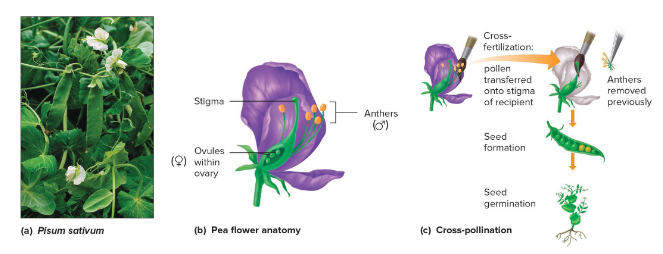
1) Seed color
2) Seed shape
3) Flower color
4) Pod color
5) Pod shape
6) Stem length
7) Flower position
What were the seven antagonistic pairs of traits studied by Mendel in pea plants?
Normally, the hydrids would resemble only one parent in the first-generation offspring
1) Removed anthers from one flower
2) Transferred pollen from anthers to the stigma of another flower with a different trait
3) Planted the seeds produced and observed traits in grown first-generation offspring
How did Mendel cross-fertilize his pea plants?
The first-generation offspring only exhibited one parental traits (yellow seeds x green seeds in the parent generation produced all yellow seeded plants)
In the second generation offspring, both parental traits appeared in a 3:1 ratio (yellow:green)
What occurred when Mendel performed single crosses with pea plants?
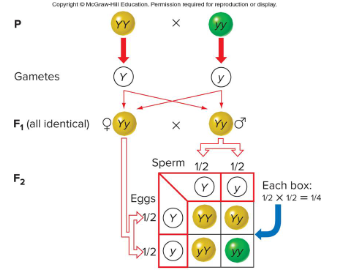
Transferred pollen from yellow peas and fertilized eggs from green peas
Also transferred pollen from green peas and fertilized eggs from yellow peas
He produced similar results to earlier experiments and disproved the blending hypothesis
How did Mendel perform his reciprocal crosses and what did these results disprove?
1) Cross-fertilized two different true breeding strains that differed in only one trait and called them the parent generation
2) Collect the seeds and plant them as the first generation offspring
3) Allow the first generation to self-fertilize and produce the seeds
4) Collect and plant the second generation seeds to observe the produced plants
How did Mendel conduct his single factor crosses?
Dominant / recessive / alleles
Fill in the blank…
Mendel proposed that each plant carrier two copies of a unit of inheritance. The trait that appeared in the F1 progeny is the ( ) form while the trait that is hidden in the F1 progeny is the ( ) form. These units of inheritance are known as genes, where alternative forms of a single gene are ( ).
Monohybrids
Individuals with two different alleles for a single trait.
Mendel’s Law of Segregation
Mendel’s theory for inheritance in which the two alleles for each trait separate during gamete formation. The two gametes, one from each parent, unite at random at fertilization.

1) Refuted the blending hypothesis (a tall plant and dwarf plant don’t make an intermediate height plant) and proposed that each trait had two variants (one dominant and one recessive)
2) Supported a particulate theory of inheritance in that genetic determinants that govern traits are inherited as discrete units (genes) that remain unchanged as they are passed from parent to offspring.
3) Proposed the law of segregation in which the two copies of a gene segregate from each other during the process that gives rise to gametes
What were the three ideas Mendel proposed after interpreting his results?
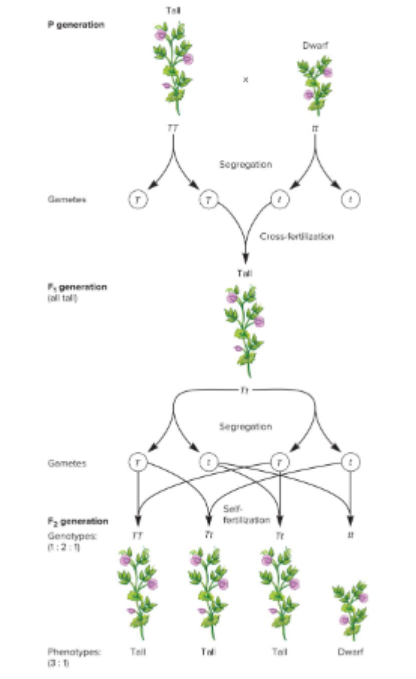
Homozygous
An individual with two identical alleles.
Heterozygous
An individual with two different alleles.
Genotype
The specific allele composition of an individual.
Phenotype
The observable traits of an individual.
Product Rule
The probability of two independent events occurring together is the product of their individual probabilities.
P(1&2) = P(1) x P(2)
Sum Rule
Probability of either of two mutually exclusive events occurring is the sum of their individual probabilities.
P(1 or 2) = P(1) + P(2)
1) Chance of Y pollen = ½ Chance of Y ovule = ½
Chance of ovule and pollen uniting = ½ x ½ = ¼
2) Chance of Y pollen uniting with y ovule = ½ x ½ = ¼
Chance of y pollen uniting with Y ovule = ½ x ½ = ¼
Chance of either event happening = ¼ + ¼ = ½
From a cross of Yy x Yy peas….
1) What is the chance of getting YY offspring?
2) What is the chance of getting Yy offspring?
Genotypes → 1:2:1 (homozygous dominant: heterozygous dominant: homozygous recessive)
Phenotype → 3:1 (dominant:recessive)
In a cross of Yy and Yy peas, the genotypes and phenotypes in the second generation offspring were present in what ratios?
Test-cross / recessive
Fill in the blank…
To reveal whether an individual with a dominant phenotype is heterozygous or homozygous, you can ( ) that individual to a homozygous ( ) individual and examine progeny.
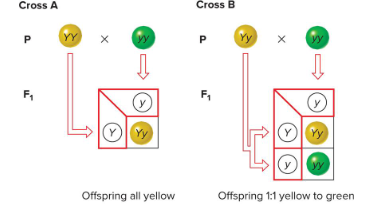
Two-Factor Crosses
Crossing individual plants that differ in two characters. It can result in two patterns of inheritance
1) Linked assortment
2) Independent assortment
Linked Assortment
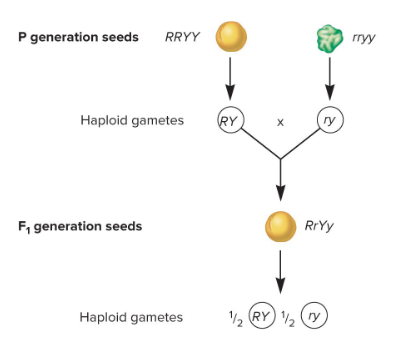
Nonparentals
Organisms in the F2 generation that had novel combinations of traits not found in the parent generations. Occurrence of these organisms contradicted the linked model of assortment.
Law of Independent Assortment
A law proposed by Mendel in which two different genes will randomly assort their genes during the process that gives rise to gametes. According to this law, the phenotypic ratio in the second generation would be 9:3:3:1.
Ex) If a parent is RrYy, the R and r alleles will segregate into gametes independently of the Y and y alleles. This will produce RY, Ry, rY, and ry gametes in equal amounts.
Y is just as likely to assort with R as it is with r and y is just as likely to assort with R as it is with r.
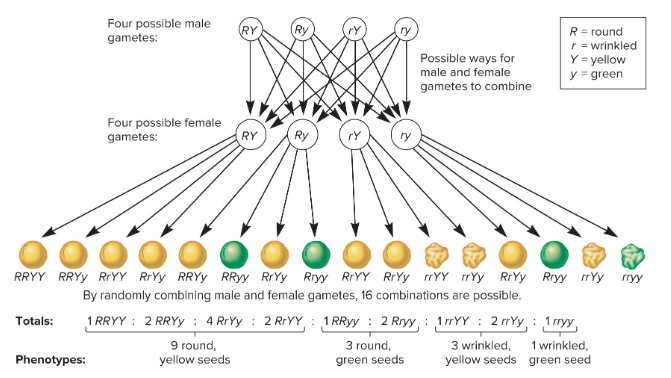
1:1:1:1 / two / two
Fill in the blank…
In Mendel’s two factor crosses, each F1 organism produced four possible gametes in a ( ) ratio. However, four phenotypic classes occurred in the second generation progeny: ( ) are like the parents and ( ) are recombinant.

P(yellow) = 12/16 = 3/4
P(wrinkled) = 4/16 = 1/4
P(yellow, wrinkled) = 3/4 × 1/4 = 3/16
In Mendel’s two-factor cross, what is the probability of having a yellow, wrinkled pea plant in the F2 generation when one individual in the P generation is YYRR and the other is yyrr?

Branched-Line Diagrams
A method of displaying the flow of traits in which progeny phenotypes for each gene are shown in different columns along with their relative frequencies.

2n / n / 16
Fill in the blank…
Mendel’s laws can be used to predict offspring in complicated crosses.
The number of different gametes is given by ( ), where ( ) is the number of different traits.
Ex) Aa Bb Cc Dd = ( ) gametes.
Aa x Aa = ¾ A-
Bb x Bb = ¼ bb
Cc x Cc = ¾ C-
Dd x Dd = ¾ D-
So, P(A- bb C- D-) = ¾ x ¼ x ¾ x ¾ = 27/256
How many progeny will show the dominant traits for A, C, and D and the recessive trait for B if Aa Bb Cc Dd is crossed with Aa Bb Cc Dd?
R / Sbe1 / r / wrinkled
Fill in the blank…
A molecular explanation for Mendel’s pea shape….
The ( ) allele encodes for the Starch branching enzyme ( ). The ( ) allele does not make this enzyme, leading to a build-up of sucrose and unbranched starch and the production of ( ) peas.
Y / stay green / chlorophyll / y
Fill in the blank…
A molecular explanation for Mendel’s pea color…
The ( ) allele encodes the ( ) enzyme Sgr, which breaks down ( ). The ( ) allele does not make this enzyme, so chlorophyll is not broken down and the peas remain green.

1) A specific gene determines a specific enzyme, whose activity may affect phenotype
2) A dominant allele determines a normally functioning protein, while a recessive allele usually does not encode a functional protein
What are two general molecular principles for genetics?
Chromosomal Theory of Inheritance
This theory describes how the transmission of chromosomes account for Mendelian patterns of inheritance. The main principles of this theory are…
1) Chromosomes contain the genetic material
2) Chromosomes are replicated and passed from parent to offspring
3) The nuclei of most eukaryotic cells contain chromosomes that are found in homologous pairs (i.e. they are diploid)
4) During meiosis, each homolog segregates into one of the two daughter nuclei
5) Each parent contributes one set of chromosomes to its offspring
Meiosis 1 / Meiosis 2 / law of independent assortment
Fill in the blank…
Homologous chromosomes segregate from each other in ( ). This leads to the segregation of the alleles into separate gametes in ( ), which explains Mendel’s law of segregation. The random alignment of homologs during meiosis also explains the ( ).
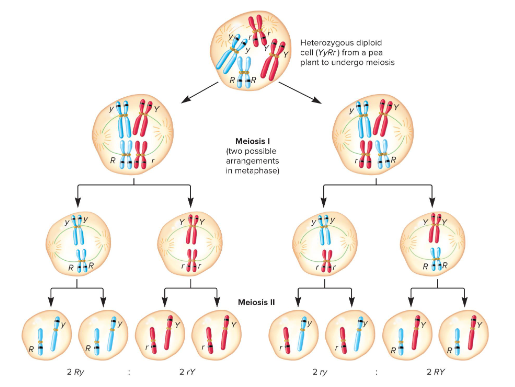
Thomas Hunt Morgan
Confirmed the chromosomal theory of inheritance by inducing mutations in the fruit fly D.melanogaster. He did this by exposing the species to X-rays, radium, and by growing them in the dark.
1) Crossed a white-eyed male with a pure-breed red-eyed female
2) Recorded the results of the traits in the F1 generation
3) Crossed the F1 generation with each other to obtain F2 offspring and record their traits
4) In a separate cross, crossed a white-eyed male from the F2 generation with a red-eyed female from the F1 generation
How did Morgan perform his test crosses?

X-Linked Genes
Genes that are physically located on the X chromosome.
0 / X
Fill in the blank…
In Morgan’s first cross, there were ( ) white-eyed females in the F2 generation. This would indicate that the eye color alleles are located on the ( ) chromosome.
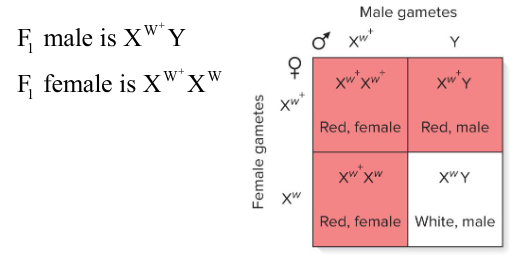
Lower
Fill in the blank…
In Morgan’s experiment, there was a 4.4:1 ratio of red to white eyes in the F2 generation. This deviated from the predicted 3:1 ratio, likely because white-eyed flies had a ( ) survival rate.
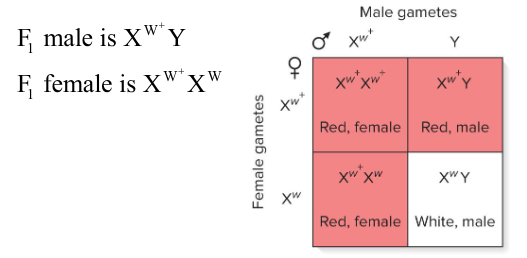
Equal / X-linked
In Morgan’s test cross, ( ) number of flies were observed (red-eyed males and females and white-eyed males and females). This is consistent with the ( ) pattern of inheritance.
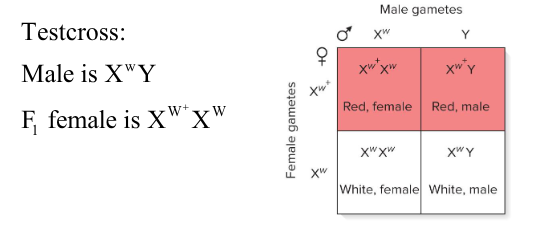
Loss-of-function Alleles
Defective copies of genes. They are often inherited in a recessive manner.
Mendel unknowingly used seven of these in his studies on pea plants.
Multiple / simple Mendelian inheritance
Fill in the blank…
Many heritable traits in humans are caused by the interaction of ( ) genes and don’t show ( ) patterns. Even for the limited number of single-gene traits, determining inheritance in humans can be tricky due to long generation times, small number of progeny, no controlled mating, and no pure-breed lines.
Recessive
Some of the most common single-gene traits like cystic fibrosis and sickle-cell anemia are caused by what types of alleles in humans?
Dominant
Some of the most common single-gene traits like Huntington disease are caused by what types of alleles in humans?
Pedigrees
Family trees that are used to determine the pattern of inheritance of traits in humans. These are used because it is unethical to control parental crosses in humans.
Unaffected individuals are unshaded while affected individuals are shaded.
1) Two unaffected heterozygous individuals will have, on average, 25% of their offspring affected
2) Two affected individuals will produce 100% affected offspring
A recessive pattern of inheritance makes what two important predictions?
1) An affected individual will have inherited the gene from at least one affected parent
2) A disease may have been the result of a new mutation that occurred during gamete formation
A dominant pattern of inheritance predicts what two things?
Htt Protein
The dominant Huntington disease allele produces an abnormal version of this protein, leading to nerve cell damage even when normal protein is present.
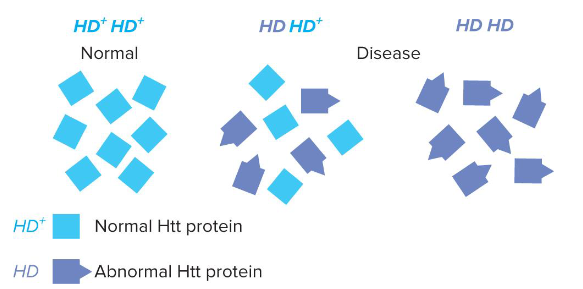
Dominant / recessive
A vertical pattern of inheritance reveals a rare ( ) trait where every affected person has at least one affected parent (mating between an affected person and unaffected person is a testcross)
A horizontal pattern of inheritance reveals a rare ( ) trait where parents of affected individuals are unaffected but are heterozygous carriers for the allele.
Cystic Fibrosis (CF)
A recessive disorder in humans that is caused by a mutant allele that encodes for a defective CFTR protein (cystic fibrosis transmembrane conductance regulator). Normally, this protein regulates ion transport across the cell membrane, but the mutated protein can’t do this and causes abnormalities in the pancreas, intestine, sweat glands, and lungs.
Heterozygous individuals (carriers) will produce enough CFTR for normal lungs function.
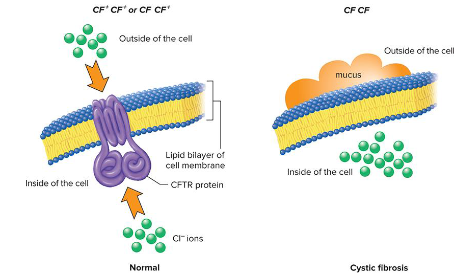
1) Affected children have at least one affected parent
2) They show a vertical pattern of inheritance
3) Two affected parents can produce unaffected children as long as the parents are heterozygotes
What are three key aspects of pedigrees with dominant traits?
1) Affected children may be the children of two unaffected parents
2) All the children of two affected parents should be affected
3) They show a horizontal pattern of inheritance
4) Recessive traits might show a vertical pattern of inheritance if the trait is extremely common (i.e. #2)
What are four key aspects of pedigrees displaying recessive traits?